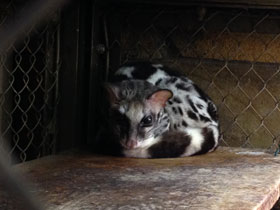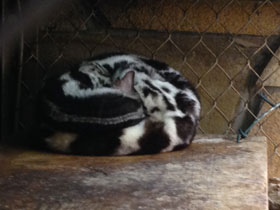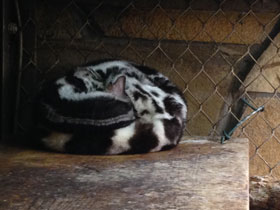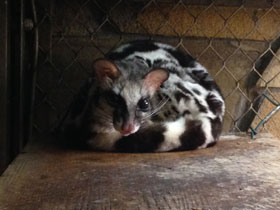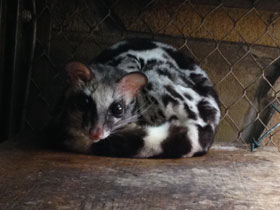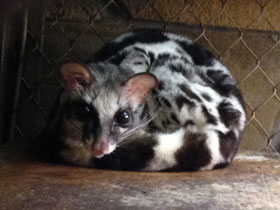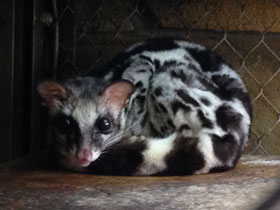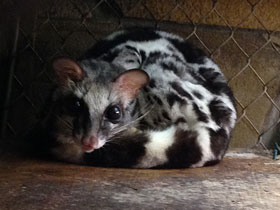The Asiatic linsang (the genus Prionodon)
The Asiatic linsang (Prionodon) is a genus comprising two species native to Southeast Asia: the banded linsang (Prionodon linsang) and the spotted linsang (Prionodon pardicolor). Prionodon is considered a sister taxon of the Felidae.
Appearance
Prionodon is the only genus of carnivorous mammals in the family Prionodontidae, and is composed of two species that inhabit Southeast Asia and Borneo. The dimensions of these amazing animals are small: their body length is 37-43 cm, their tail length is slightly less (30-35 cm), and their weight varies between 590 and 800 grams. Prionodon have a very slender build. They have elongated bodies, necks and snouts with long vibrissae. Prionodon have slender limbs and small, clean feet with retractable claws. The hind legs of these animals have protective leathery paddles. Their hairs are short, dense and soft, resembling velvet; the tail and soles of the feet are also covered with wool. Prionodonts have large, rounded, dark eyes; their ears are medium-sized, mobile and rounded at the ends. The striped prionodont is whitish-grey or brownish-grey on the dorsal part of the body and cream on the abdomen, with four or five broad black and dark brown stripes on the dorsum. It has dark spots on the sides of the body and on the limbs; the tail has alternating light and dark rings. The spotted Prionodon is orange-brown or light brown. The black spots on the upper body extend in more or less regular rows. Prionodon has 8 or 10 dark rings on the tail.
Distribution and breeding
Prionodon is distributed in Nepal, Assam in India, Burma, Indochina and the islands of Malacca, Sumatra, Java and Kalimantan. Its ecology is poorly studied. Voles are known to inhabit dense forests and bushes. They are mainly active at night and are excellent tree climbers. The prionodon feeds mainly on birds, but also on small mammals, amphibians, reptiles and invertebrates. Females produce two litters per year of 2 or 3 young each. Breeding probably takes place in February and August.
It is a genus consisting of two species:
- Prionodon linsang, striped linsang, which inhabits the Malay Peninsula and the islands of Java and Borneo;
- Prionodon pardicolor, spotted linsang, which ranges from India, Nepal, Bhutan and southern China to Vietnam, northern Thailand, northern Burma, Laos and Cambodia.
Description and distribution
Prionodon linsang has a body length of 37.5 to 43 cm and a tail of 30.5 to 35.5 cm. This slender and graceful beast is light grey or brownish-grey in colour and is decorated with 4 or 5 black transverse stripes. It has dark spots on its sides and legs. It lives in the forests of Thailand, Malaysia, Sumatra and Kalimantan. This nocturnal animal spends most of its time in trees, climbing and jumping deftly and quickly over them. It is no less agile on the ground. This species lives in dense tropical rainforests. It is rarely seen in dry forests and near human settlements at altitudes of no more than 1800m.
Nutrition and reproduction
The prionodon feeds on insects, small lizards and snakes, frogs, birds and their eggs, small mammals and sometimes eats fruit. These graceful predators ambush their prey by lying on their stomachs with their tails straight up, which is why they are often mistaken for snakes. Prionodonts hunt at night and rest in their nests during the day.
They make their nests out of dry leaves and small branches in hollows or burrows. There may be one or two (more often two) calves in a litter. Calves are born blind and helpless. Their birth weight is about 40 grams. They do not leave the nest until they are weaned. The male does not participate in the rearing of the young.
With Viverridae (morphological)
Prionodon was denominated and first described by Thomas Horsfield in 1822, based on a linsang from Java. He had placed the linsang under ‘section Prionodontidae’ of the genus Felis, because of similarities to both genera Viverra and Felis. In 1864, John Edward Gray placed the genera Prionodon and Poiana in the tribe Prionodontina, as part of Viverridae. Reginald Innes Pocock initially followed Gray's classification, but the existence of scent glands in Poiana induced him provisionally to regard the latter as a specialized form of Genetta, its likeness to Prionodon being possibly adaptive. Furthermore, the skeletal anatomy of Asiatic linsangs are said to be a mosaic of features of other viverrine-like mammals, as linsangs share cranial, postcranial and dental similarities with falanoucs, African palm civet, and oyans respectively.
With Felidae (molecular)
DNA analysis based on 29 species of Carnivora, comprising 13 species of Viverrinae and three species representing Paradoxurus, Paguma and Hemigalinae, confirmed Pocock's assumption that the African linsang Poiana represents the sister-group of the genus Genetta. The placement of Prionodon as the sister-group of the family Felidae is strongly supported, and it was proposed that the Asiatic linsangs be placed in the monogeneric family Prionodontidae. There is a physical synapomorphy shared between felids and Prionodon in the presence of the specialized fused sacral vertebrae.









